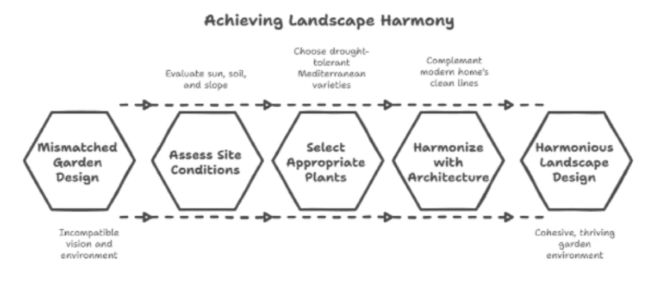Garden Design: Matching Your House & Location
The $85,000 Garden Renovation Disaster That Could Have Been Prevented With Proper Site Analysis

Two years ago, while working at Realmo, I watched a successful tech executive named Jennifer make one of the most expensive landscaping mistakes I’ve ever witnessed. She had purchased a stunning $1.8 million contemporary home in the hills outside Seattle and immediately hired an award-winning landscape designer to create what she called her “dream English cottage garden.”
Jennifer’s vision was inspired by gardens she’d admired during trips to the Cotswolds – overflowing perennial borders, climbing roses on weathered arbors, and meandering stone paths through informal plantings. The landscape designer, eager to please a high-budget client, promised to recreate that romantic English aesthetic despite obvious problems with the site and architectural mismatch.
The designer ignored fundamental incompatibilities between Jennifer’s vision and reality. The house was a sleek, modern structure with clean lines, floor-to-ceiling windows, and minimalist materials that celebrated contemporary design. The site was a steep, south-facing slope with sandy, fast-draining soil and intense summer sun exposure – conditions opposite to the cool, moist, sheltered environments where English cottage gardens thrive.
Jennifer invested $85,000 in the initial installation: importing tons of rich, moisture-retentive soil amendments, installing an elaborate irrigation system, constructing rustic stone walls and pathways, and planting hundreds of traditional cottage garden perennials including delphiniums, foxgloves, astilbe, and rambling roses that required cool, moist conditions.
The garden looked spectacular for exactly six weeks.
By late summer, the intense Pacific Northwest sun had scorched the shade-loving perennials. The fast-draining sandy soil couldn’t retain enough moisture to support water-hungry plants despite constant irrigation. The romantic, informal cottage garden aesthetic clashed so dramatically with the modern house that the overall property looked confused and disjointed.
Within 18 months, 70% of the original plantings had died or performed so poorly that Jennifer hired a different landscape designer to completely redesign the space. The second renovation cost an additional $65,000 as the new designer removed failed plantings, modified hardscaping, and installed drought-tolerant Mediterranean plants that actually thrived in the site conditions.
Why Site Analysis Determines Garden Success Before You Plant Anything
The fundamental mistake most homeowners make is choosing garden styles based on aesthetic preferences while ignoring whether their site conditions and house architecture can support those design visions.
Successful gardens require harmony between three elements: architectural style of the house, natural conditions of the site, and maintenance capabilities of the owner. When any of these elements conflict with the garden design, the result is either expensive failure or ongoing frustration from fighting natural conditions.
Most garden failures stem from attempting to impose inappropriate plant palettes or design styles rather than developing concepts that work with existing conditions. Fighting site conditions through soil amendments, irrigation systems, and climate modification techniques typically requires ongoing inputs that make gardens expensive and time-consuming to maintain.
Hidden Costs of Ignoring Site Conditions
Working against natural site conditions creates ongoing expenses that turn dream gardens into financial nightmares through maintenance requirements and replacement plantings that homeowners rarely anticipate during initial planning.
Irrigation System Dependencies and Water Costs
Gardens planted with inappropriate species for local rainfall patterns require extensive irrigation systems that increase installation costs and create permanent dependencies on artificial watering that many regions can’t sustainably support.
I recently evaluated a failed garden where the owners had installed $15,000 worth of irrigation equipment to support tropical plants in a Mediterranean climate. Annual water costs exceeded $3,000 while plants still struggled during natural dry periods that irrigation couldn’t completely overcome.
Soil Amendment and Maintenance Expenses
Attempting to dramatically alter soil conditions through massive amendments often fails as natural drainage patterns, pH levels, and soil chemistry gradually reassert themselves despite expensive initial modifications.
I’ve seen homeowners spend $8,000 annually on soil amendments, fertilizers, and pest control trying to grow acid-loving plants in naturally alkaline soils or moisture-loving plants in naturally dry conditions. These ongoing inputs represent permanent garden expenses that continue indefinitely.
Plant Replacement and Redesign Costs
Gardens planted with inappropriate species typically require 40-70% plant replacement within three years as unsuitable plants fail despite optimal care and maintenance efforts. These replacement costs often exceed original installation expenses.
The psychological toll of watching expensive plants fail despite careful attention discourages many homeowners from continuing garden investments, leaving them with partially completed landscapes that reduce property values rather than enhancing them.
Architectural Style and Garden Harmony Principles
Understanding how architectural styles relate to appropriate garden designs prevents expensive aesthetic mismatches while creating cohesive outdoor spaces that enhance property values and visual appeal.
Contemporary and Modern Architecture Garden Compatibility
Clean-lined modern houses require garden designs that echo architectural simplicity through geometric plantings, limited color palettes, and emphasis on plant form rather than busy textures or cottage garden abundance.
Modern architecture pairs well with architectural plants like ornamental grasses, sculptural succulents, and specimen trees used as focal points rather than crowded perennial borders that compete with building lines for visual attention.
Hardscaping materials for modern homes should complement building materials – concrete, steel, and glass architecture works with poured concrete patios, corten steel planters, and geometric water features rather than rustic stone walls and informal pathways.
Traditional and Historical Architecture Garden Approaches
Colonial, Victorian, and craftsman-style homes typically support more elaborate garden designs with mixed plantings, varied textures, and traditional materials like brick, natural stone, and wooden structures that reference historical garden traditions.
These architectural styles can accommodate more complex color schemes and layered plantings because the houses themselves feature decorative details and varied materials that complement garden abundance rather than competing with it.
Traditional homes often benefit from formal elements like symmetrical plantings, defined garden rooms, and classical features like arbors or pergolas that echo historical landscape design principles while providing structure for informal plantings.
Transitional Styles and Flexible Design Approaches
Houses that blend traditional and contemporary elements offer flexibility in garden design but require careful balance to avoid appearing indecisive or confused in overall landscape approach.
Transitional gardens often succeed through simplified traditional elements – formal layouts planted with contemporary plant palettes or modern materials used to create classical garden structures that bridge architectural styles.
Site Condition Assessment and Plant Selection Strategies
Creating successful gardens requires systematic evaluation of site conditions to determine which plant communities will thrive rather than merely survive in specific environmental conditions.
Microclimate Identification and Utilization
Every property contains multiple microclimates created by building shadows, wind patterns, elevation changes, and proximity to heat-absorbing or heat-reflecting surfaces that create opportunities for diverse plant communities.
South-facing walls create warm, protected microclimates suitable for plants that are marginally hardy in the general climate, while north-facing slopes remain cooler and moister, supporting different plant palettes.
Understanding these variations enables gardeners to select appropriate plants for specific locations rather than treating entire properties as uniform growing environments that require identical plant selections.
Soil Condition Evaluation and Plant Matching
Rather than extensively modifying soil conditions, successful gardens match plant selections to existing soil drainage, pH, and nutrient characteristics while making minimal amendments that support rather than transform natural conditions.
Clay soils support different plant communities than sandy soils, and working with these differences creates more sustainable landscapes than attempting to create uniform growing conditions throughout entire properties.
Drainage patterns determine plant selection more than any other factor because most plant failures result from water-related stress – either too much or too little moisture for specific species requirements.
Native Plant Integration and Ecosystem Benefits
Native plants adapted to local conditions typically require minimal inputs while providing maximum ecological benefits through wildlife habitat, pollinator support, and integration with existing natural systems.
Regional native plant communities offer tested combinations that work together aesthetically and ecologically while requiring minimal maintenance once established in appropriate site conditions.
I’ve found that gardens incorporating 60-70% native plants typically establish faster, require less maintenance, and provide more wildlife habitat than gardens dominated by exotic species that need ongoing support to thrive.
Design Implementation Strategies That Work With Natural Conditions
Successful garden implementation requires developing design approaches that enhance rather than fight existing site characteristics while creating beauty through working with natural patterns and processes.
Drainage Pattern Integration and Water Management
Rather than fighting natural water flow patterns through drainage modifications, successful designs incorporate existing drainage as design elements through rain gardens, seasonal streams, and moisture-loving plant communities in naturally wet areas.
Elevated planting areas and improved drainage work well in naturally wet spots for plants requiring better drainage, while low-lying areas can be enhanced with plants that thrive in seasonal moisture rather than attempting to dry them out completely.
Slope Management and Terracing Strategies
Steep slopes offer opportunities for dramatic plantings and terraced garden rooms rather than representing problems to overcome through extensive grading that destroys natural topography and creates erosion problems.
Retaining walls and terracing should follow natural contours rather than imposing geometric patterns that fight natural slope characteristics while creating maintenance and drainage challenges.
Wind Pattern Considerations and Plant Protection
Understanding prevailing wind patterns helps determine appropriate plant selections and placement of windbreaks that protect sensitive plants while enhancing rather than blocking desirable air movement for plant health.
Strategic windbreak placement can create protected microclimates for less hardy plants while maintaining air circulation that prevents fungal problems and supports healthy plant growth.
Long-Term Success Through Seasonal Planning
Creating gardens that provide year-round interest requires understanding seasonal changes and planning plant combinations that ensure continuous appeal while working within natural growth cycles.
Four-Season Interest and Plant Selection
Successful gardens provide visual interest throughout the year through combinations of evergreen structure plants, seasonal flowering plants, and plants with attractive winter characteristics like interesting bark or persistent seed heads.
Rather than focusing only on peak bloom periods, year-round planning ensures gardens remain attractive during dormant seasons while providing wildlife habitat and visual anchors when deciduous plants lose their leaves.
Maintenance Planning and Seasonal Care
Garden maintenance requirements should align with homeowner capabilities and seasonal availability rather than requiring intensive care during periods when owners prefer other activities or travel commitments.
Low-maintenance design strategies include selecting plants with similar care requirements, grouping plants by watering needs, and creating garden areas that can be maintained efficiently without requiring daily attention during busy periods.
Making Smart Decisions About Garden Design and Implementation
Jennifer’s $150,000 lesson demonstrates that beautiful garden inspiration photos don’t guarantee successful implementation when site conditions and architectural styles can’t support specific design approaches.
Key principles for successful garden design include:
Assess Before Design: Understand soil conditions, drainage patterns, sun exposure, and microclimates before selecting plants or design styles rather than imposing preconceived aesthetic preferences.
Match Architecture: Choose garden styles that complement house architecture while enhancing rather than competing with building characteristics and overall property aesthetic.
Work with Natural Conditions: Select plants adapted to existing site conditions while making minimal modifications that support rather than transform natural environmental characteristics.
Plan for Maintenance: Design gardens that match long-term maintenance capabilities rather than creating beautiful installations that become burdensome or expensive to maintain properly.
Invest in Professional Analysis: Spend money on proper site assessment and design consultation rather than expensive plant installations that may fail due to poor site matching.
For homeowners ready to create successful landscapes, the foundation of beautiful gardens lies in understanding and working with existing conditions rather than fighting natural characteristics through expensive modifications and inappropriate plant selections


